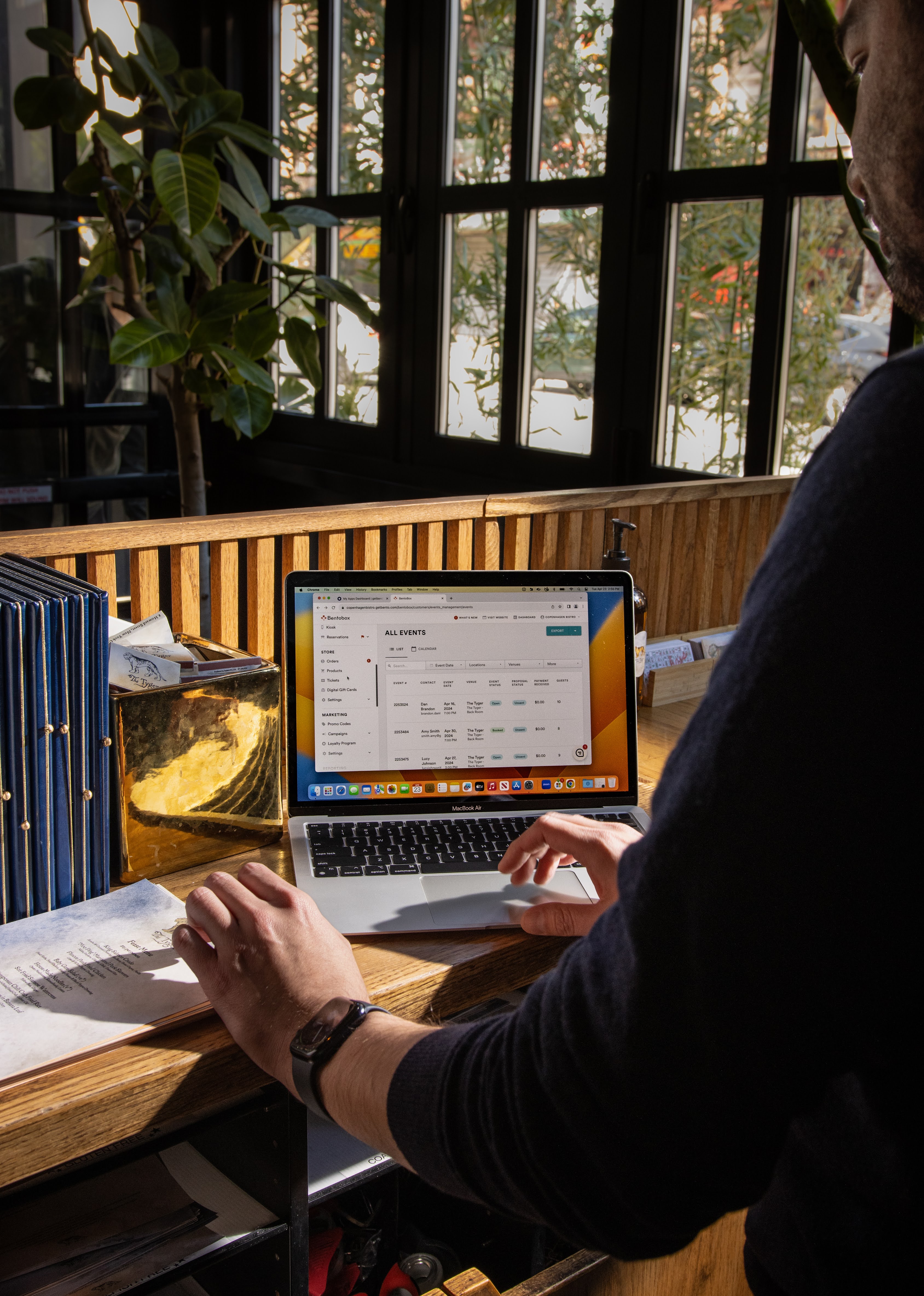Operations
7 Restaurant Sustainability Best Practices to Know
A look at how and why restaurants are building sustainability into their brands.
Sustainability is an important issue that more and more diners care about. As the world moves toward a greener future, restaurants are doing their part to lead the change.
Ultimately, efficient sustainability practices cut costs and save restaurants money. Even the most simple of actions can have great effects. For example, according to the National Restaurant Association’s Conserve Program, fixing small leaks in the kitchen can save restaurants up to $400 and preserve an essential natural resource in the process. Another simple example: shutting down a single piece of kitchen equipment for 30 minutes a day can save a restaurant $100 a year. Each tactic adds up.
For restaurants that are new to the sustainability space, below are seven areas to start when making adjustments. Many restaurants already have strong sustainability efforts in place but need help promoting their work. Keep reading for six examples from real restaurants on how to share your sustainability story on your website.
How Restaurants Can Become More Sustainable
Executing sustainability best practices fosters better brand affinity and loyalty from diners that share the same values. While the steps outlined below require some amount of research, resources, and time, they’re part of a long term plan. Here are a few sustainable practices for restaurants to explore.
Eliminate single-use plastics.
Find alternatives to plastic straws and cutlery. Use recycled paper bags for takeout. Source recycled to-go boxes and containers. All of these things help minimize waste!
If you’re looking for support in this area, check out an organization called Beyond Plastics, which released this free guide: Hold The Plastic, Please: A Restaurant’s Guide To Reducing Plastic. In the 50-page PDF, there’s insight into how to perform a plastic audit, tips for getting buy-in from your staff and engaging your team, purchasing resources for reusable takeout containers, and examples of back-of-house storage systems that don’t require single-use plastic.
Source locally for meat and produce.
Restaurants can look to their own backyard when procuring ingredients and produce. Sourcing locally supports the local economy, fosters growth in the community, and creates jobs. Seamore’s is a leader in this space. They were one of the first restaurants in New York City to sustainably source their seafood.
“We work with a single seafood market, Greenpoint Fish & Lobster Co. Vinny Milburn is our sole fishmonger,” said Giovanna Kupiec, Sustainability & Marketing Manager at Seamore’s. “He is the only thing in between us and the fishermen and growers.”
Ask suppliers about their sustainable practices.
A big part of becoming a more sustainable restaurant means working with wholesalers that equally value sustainability and incorporate it into their business model.
Baldor, a food distributor serving the Northeast and Mid-Atlantic regions, supports two programs that help minimize waste. Their SparCs program takes the surplus from processed fruits and vegetables and partners with chefs who incorporate these ingredients into broths and sauces. Additionally, restaurants can shop from Baldor’s line of Imperfect Produce — food that doesn’t meet the industry’s aesthetic standards but is perfectly edible — at a reduced cost of what “perfect produce” costs.
Reduce waste through ingredient utilization and inventory management.
“Root to stem” and “nose to tail” cooking — using every part of an ingredient — is one way to revise your food prep for better efficiency. Effective inventory management (like FIFO: first in, first out), also helps to cut down on waste.
Read more: How to Minimize Restaurant Food Waste
Look into food donation programs in your area.
The first step in managing excess food should be exploring food donation, as deemed by the food recovery hierarchy. Sustainable America’s Food Rescue Locator map shows food rescue organizations near your zip code that take on the logistics, coordination, and often the transportation required when donating food. On a food rescue organization’s profile, you can see the food that’s accepted, where it’s distributed, requirements for food donors, and hours of operation.
Learn about local composting programs.
Of the 12.9 million tons of surplus food created by restaurants each year, only 13% is composted. Many states have waste bans in place that restrict how much food can be thrown away by restaurants, so composting is a great choice from both a legal and financial perspective. FindAComposter.com is a helpful tool.
Use digital design to reduce in-house waste.
Digital design allows menus to be housed fully online and accessible through QR codes. This also allows restaurants to update their menus as often as they want without needing to print new menus each time there is a menu change.
Another huge source of waste in restaurants is receipts. Adopting “pay-at-table” or QR code payment methods is a great solution to this problem since the paper receipt will only be generated if requested. This solution is not only great for the environment but also increases table turnover which brings more revenue to the restaurant.
How to Talk About Restaurant Sustainability
Many restaurants are sharing more about their practices in their marketing efforts — particularly on their websites.
The reason? Consumers are interested in hearing more about restaurant sustainability.
In fact, 38% say they’re more likely to choose a restaurant that offers locally-sourced foods over one that doesn’t, and 55% of consumers consider a restaurant’s food waste reduction efforts an important factor when deciding where to eat. What’s more, consumers are actually willing to spend more money at restaurants that are investing in these efforts — 43% of diners will pay more for sustainable restaurant takeout.
Whether you’re sourcing local ingredients or implementing waste-reducing tactics, highlighting your sustainability efforts illustrates transparency and builds trust with diners. Given that 77% of diners check a restaurant’s website before visiting, featuring your sustainability practices on your website is a smart way to share this information.
There are four main ways to promote your restaurant's sustainability work across your digital storefront. You can:
Publish your sustainability statement.
Document your efforts.
Highlight your local vendors.
Showcase certificates & awards.
Read on to see how real restaurants are featuring sustainability on their website following the four guidelines above.
1. Marlow Bistro
Marlow Bistro in New York City shares their sustainable practices and policies on their website. The topic is so important to the Mediterranean spot that their Sustainability page lives in the top navigation bar for prime visibility. On the page, details are given about how the restaurant uses recyclable packaging and service ware, adheres to a commercial composting program, and partners with local organizations to donate surplus food.
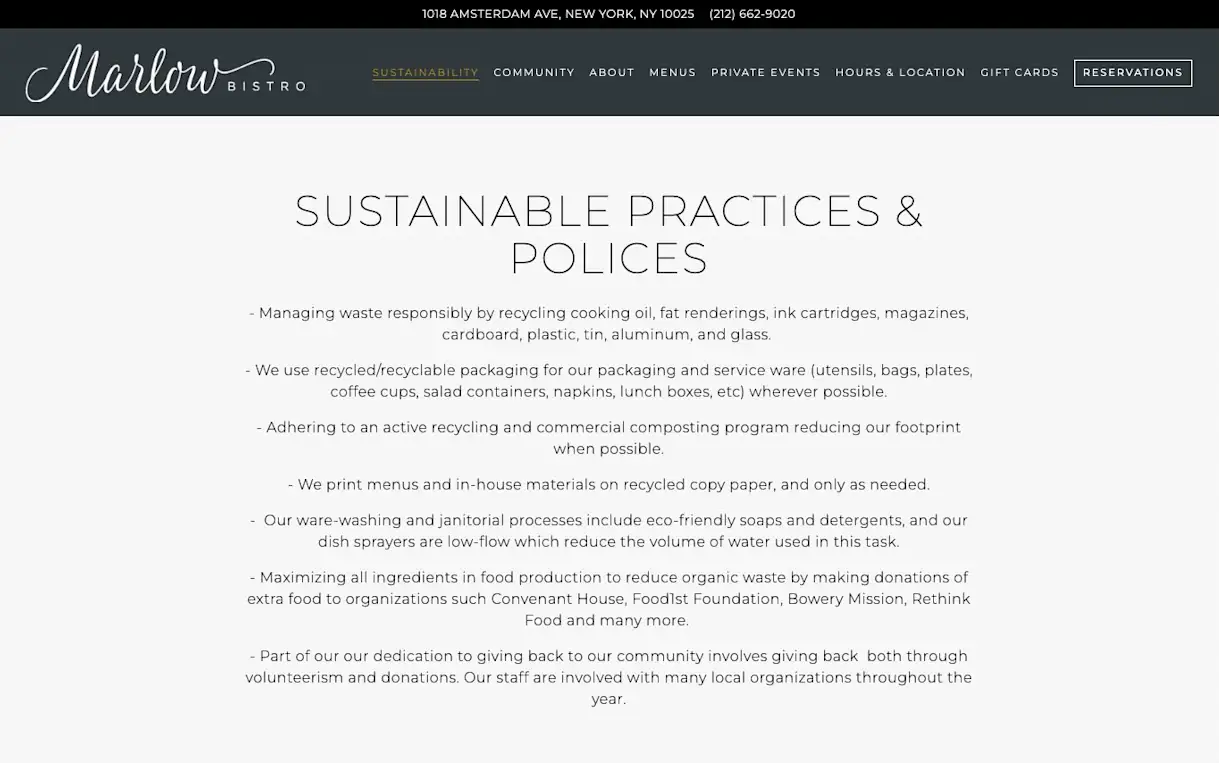
2. Snappy Salads
Sustainability is a core part of the operations at Snappy Salads, which has multiple locations around the Dallas area. Their website shares that they’ve been offering biodegradable and compostable straws since 2014 and their bottled water is captured, filtered local rainwater that’s sold in biodegradable containers. Beyond packaging, eco-friendly efforts are made across the physical space as well. The countertops at each location are upcycled and made from a combination of recycled brown beer bottles, green wine bottles, white porcelain, and shiny mirrors. Plus, the tables and stools in the dining area are created from salvaged wood.
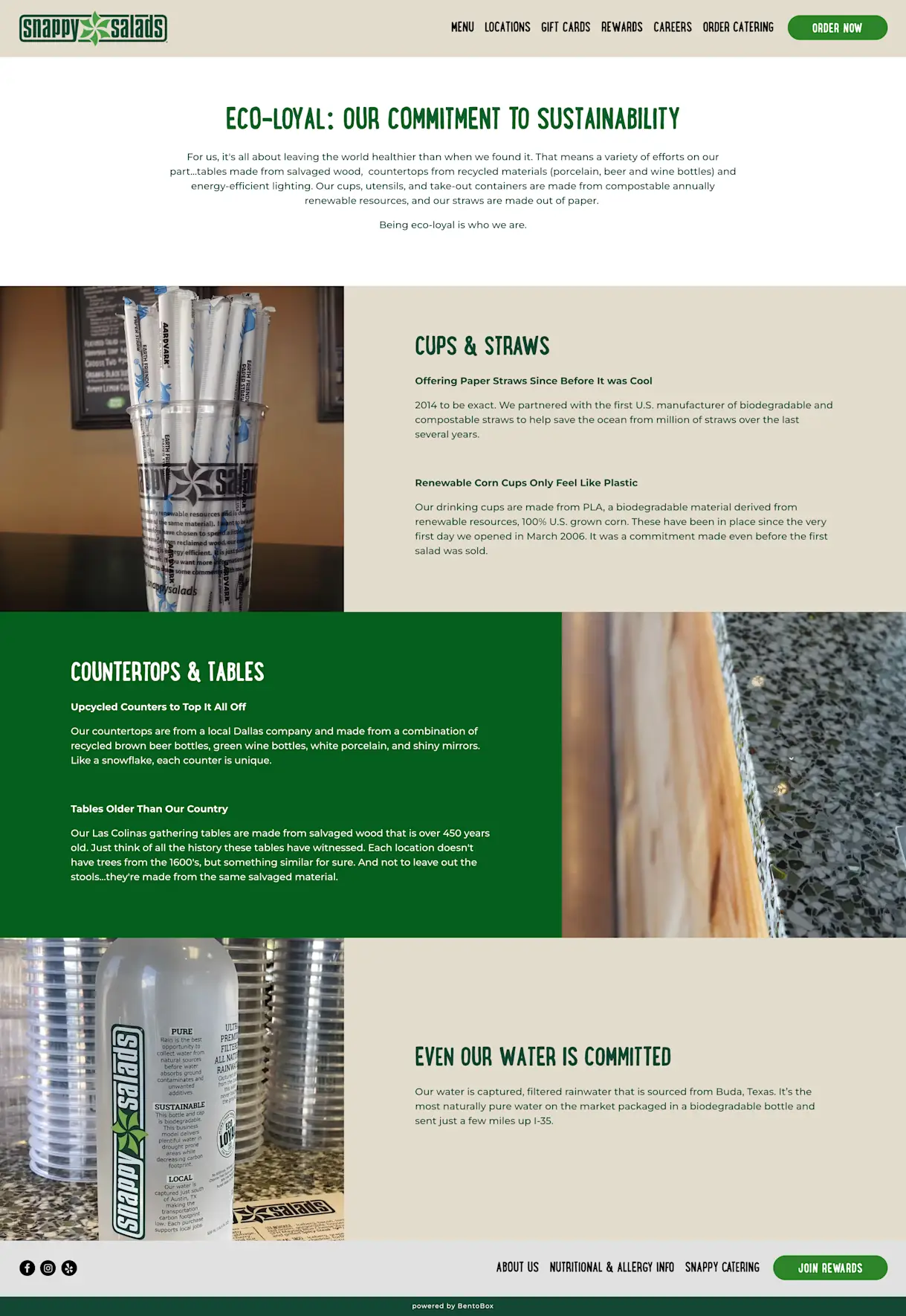
3. Landfall
Landfall in Woods Hole, Massachusetts shows the value of transparency with their sustainability page, calling out that the restaurant began taking a series of steps in 2018 to be more environmentally conscious. Some of their efforts have included taking better care to divert food scraps from the waste stream, decreasing the use of plastic straws, and changing from incandescent and fluorescent lights to LED lights to reduce electricity consumption.
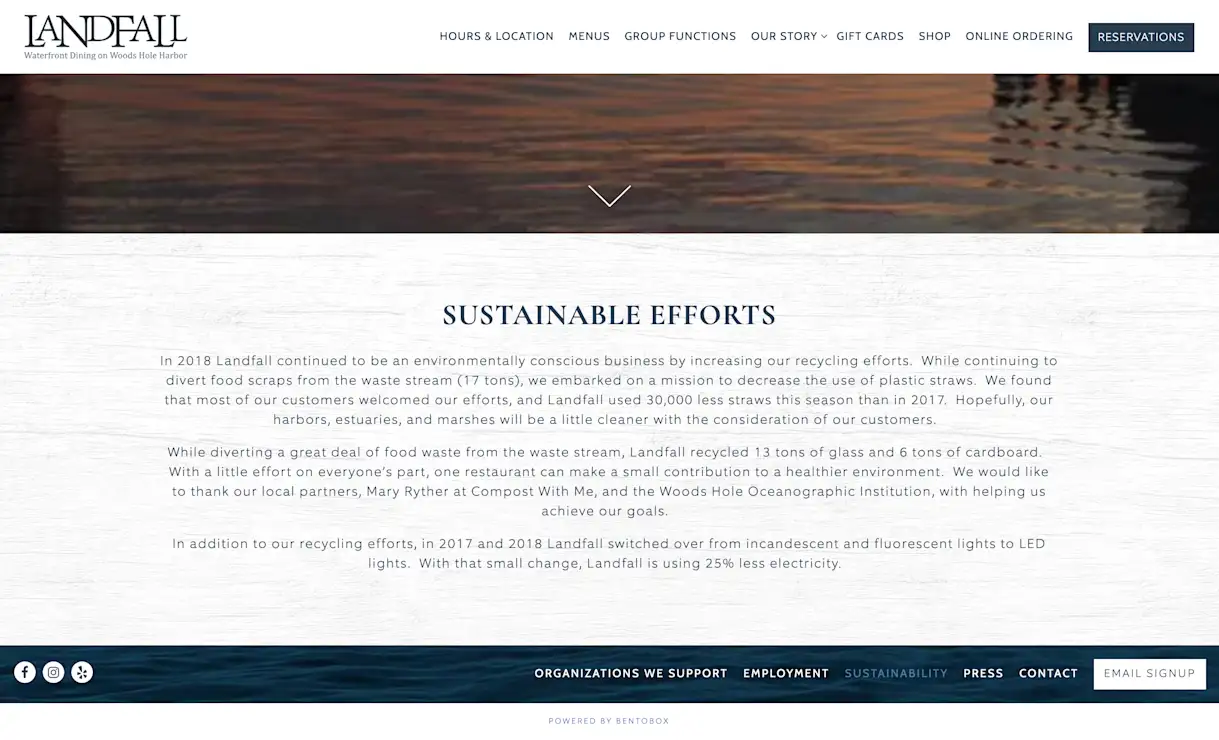
4. The New Moon Cafe
The New Moon Cafe (with spots in South Carolina and Georgia) shares a behind-the-scenes look at their composting efforts — complete with photos and videography. Since 2019, the coffee shop has diverted over 50 tons of waste from going to landfill by composting their spent coffee grounds, food scraps, and brown paper. The process creates soil that is used in the cafe garden.
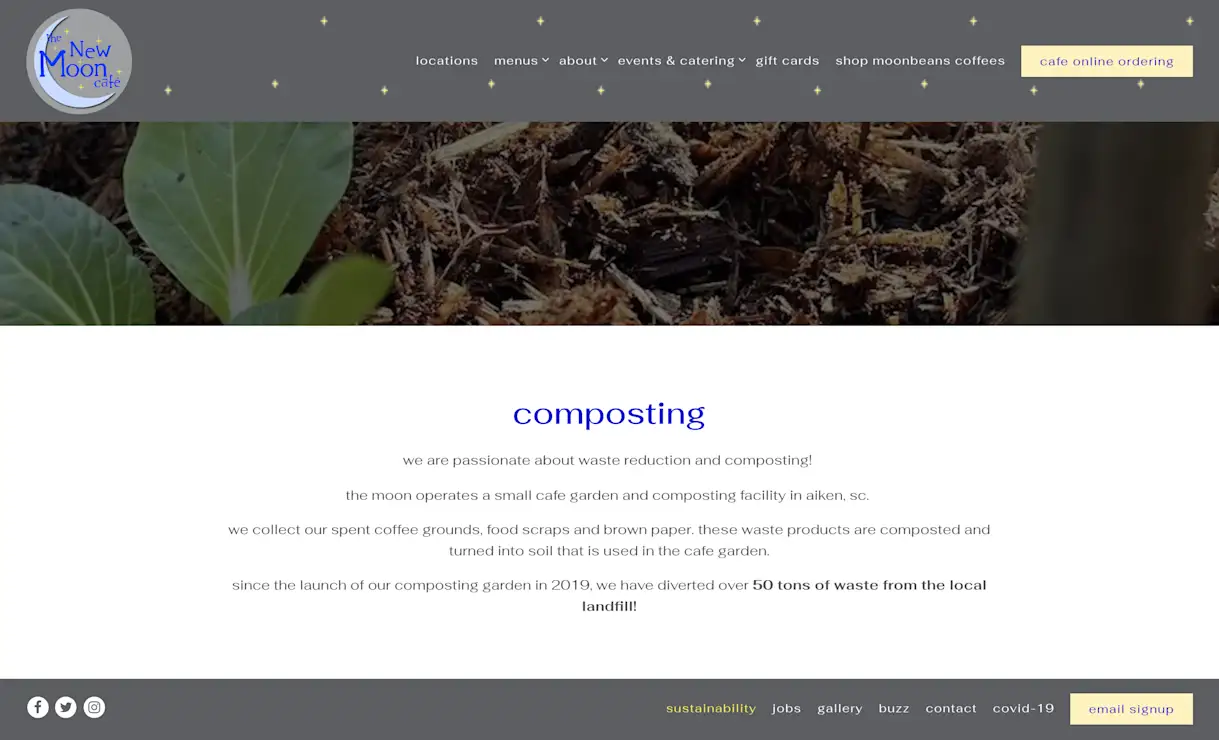
5. Urban Farmer
Urban Farmer’s messaging talks about using responsibly sourced food and high-quality ingredients, and their sourcing & sustainability page gives the details on how they act on that promise. By partnering with farmers and ranchers nearby, the restaurant makes use of local harvests and seasonal ingredients for their menu. And they practice what they preach by giving visibility to their list of partners.
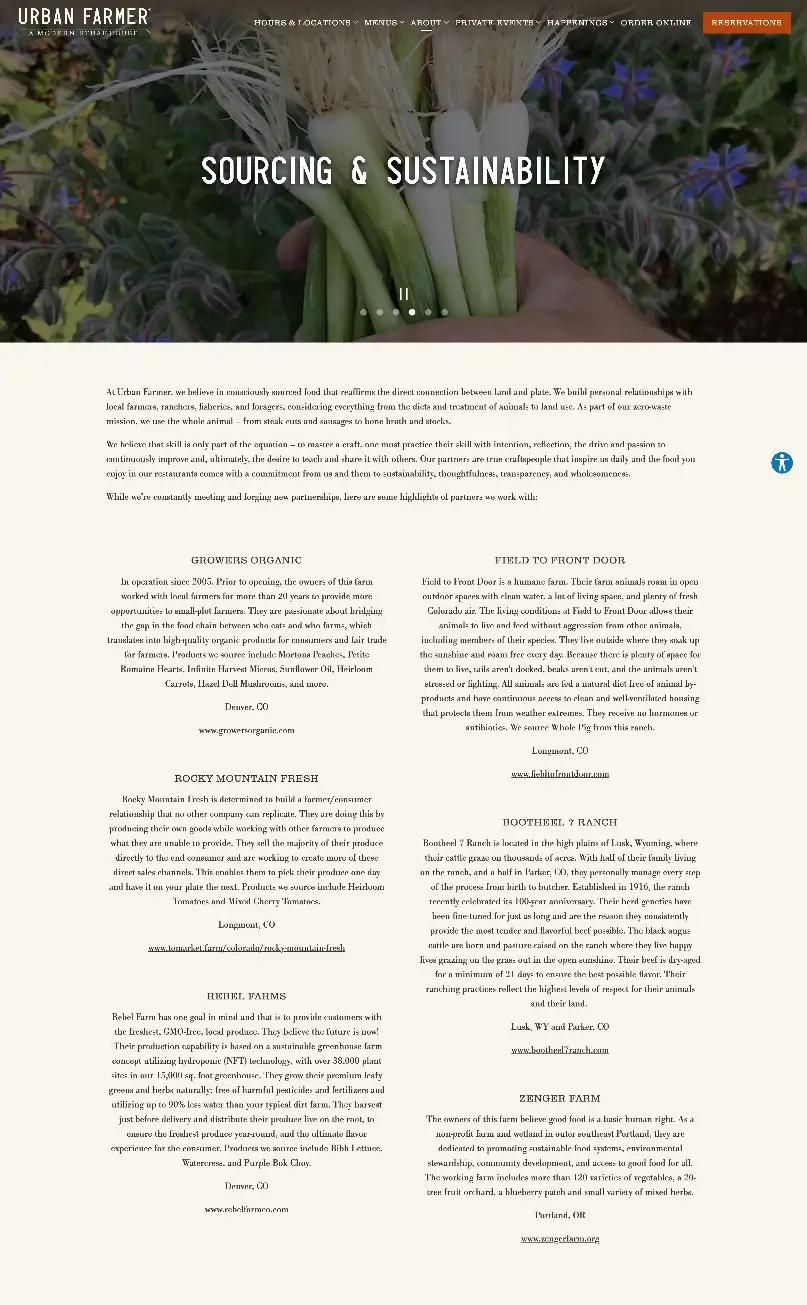
6. Jax Fish House & Oyster Bar
Has your restaurant been recognized for sustainability efforts? Share the news with your website visitors. Jax Fish House & Oyster Bar calls attention to the fact that their restaurants were the first in the states of Colorado and Missouri to be certified by the Monterey Bay Aquarium Seafood Watch, a program that assesses how fisheries and aquaculture operations perform against science-based standards for environmental sustainability.
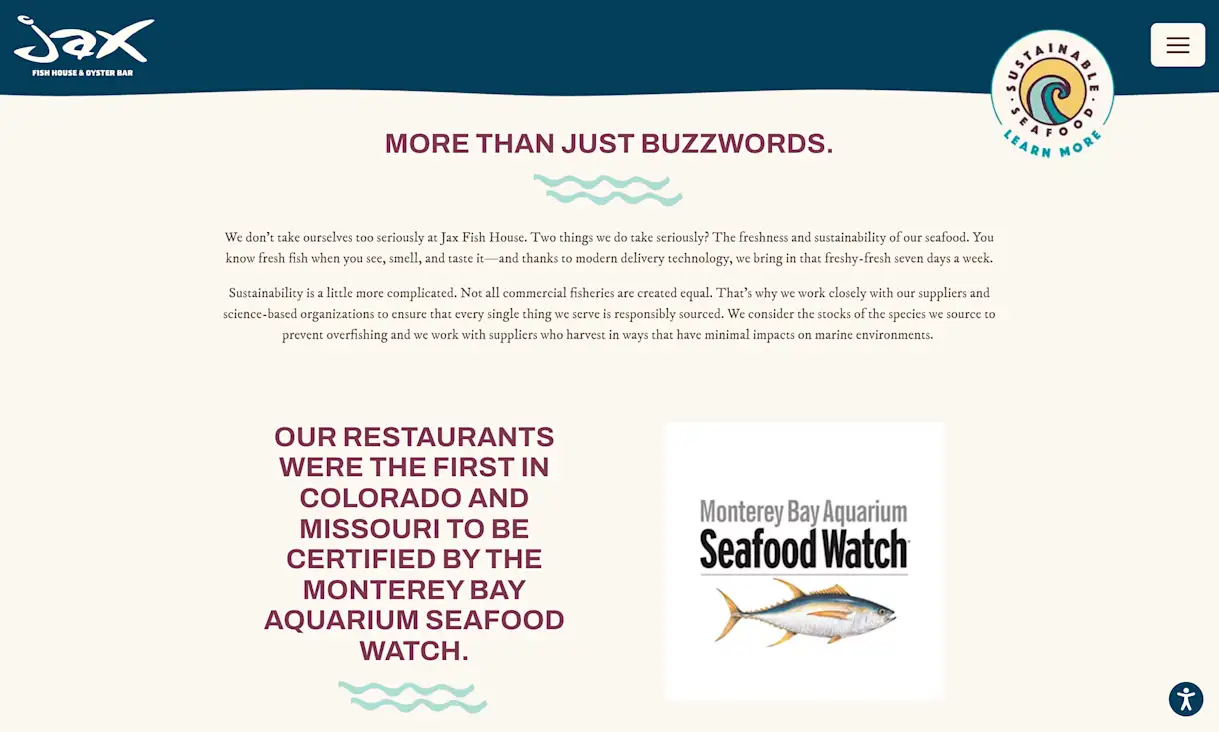

DEMO REQUEST
Highlight Sustainability on Your Website
We’ll help you showcase your sustainability efforts online with a beautiful, customized website.
Recommended
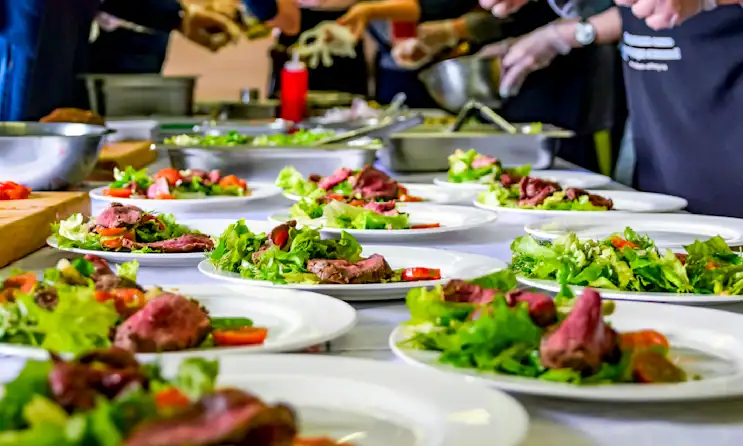
Operations
How to Reduce Food Waste in Restaurants
July 6, 2022
Improve your bottom line, supercharge your sustainability practices and stay in compliance with state regulations using these tips.

Websites
How to Choose a Restaurant Website Design Company
May 20, 2021
What to look for when searching for a restaurant website design partner.

Operations
The Ultimate Guide to Restaurant Inventory Management
January 13, 2022
Learn the terms, steps and metrics that aid in the process of this key business process.
